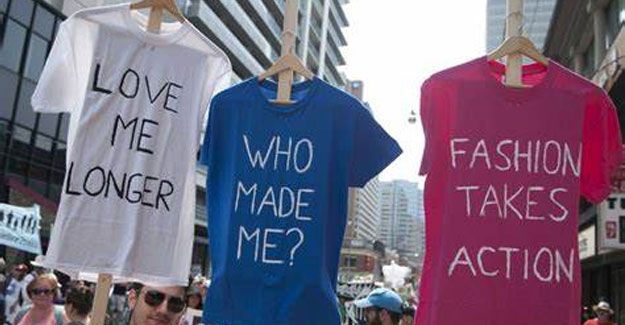
Degrowth Could Make Fashion More Sustainable
Somewhere between 80 billion and 150 billion garments are produced and sold every year. The fashion industry has to cut out rampant overproduction and overconsumption in order to pull back greenhouse gas emissions, reduce clothing waste and mitigate environmental degradation. Why does fashion overproduce? To answer this question, we have to understand the bigger cultural and economic structures that enable fashion’s overproduction. “The driver is people with capital that are trying to make their capital grow by exploiting whatever opportunities come along,” explains Susan Paulson, professor at the Center for Latin American Studies at the University of Florida and co-author of “The Case for Degrowth.” These shareholders demand sales growth from the businesses they help fund no matter the cost to society and the environment. “It’s driving designers, consumers, farmers, and everyone else to dance to this tune,” says Paulson. “It’s a race to the bottom,” says Natascha Radclyffe-Thomas, professor of marketing and sustainable business at the British School of Fashion. “We need to redress the balance,” she explains, so that people working in fashion aren’t “forced into that mentality where they’re flying around the world to save one penny, or blackmailing their factories.” “The efficiencies of digital and delivery,” says Radclyffe-Thomas, “are the worst things that we could have done in this space because it’s causing people to buy, buy, buy.” How to apply degrowth to the fashion industry There’s no single solution to replace the current consumption model. Experts mention clothing rental, mending and making, fashion detox challenges like Remake’s No New Clothes pledge, buying second-hand and vintage, fashion made from textile waste, reselling, tailoring and swapping as more positive pathways for our relationship with fashion consumption. What about the garment workers? However, to shrink manufacturing would surely cause job losses and devastation for millions of garment workers. “The garment industry,” says Radclyffe-Thomas, “has been an enabler for economies like China, Bangladesh, Vietnam, to industrialise.” :But the jobs fashion creates in these countries don’t offer enough to live on, while poisoning local communities. Is $95 a month really worth the devastating health effects of toxic effluent and 14-hour workdays?” Paulson says that a degrowth economy could put the power back in the hands of countries that are dependent on the international fashion industry, so they can sustain their economy in a way that benefits their citizens. The countries already pursuing degrowth In Bhutan, the degrowth theory has been put into practice with the implementation of Gross National Happiness or GNH. “It focuses on inner-contentment, peace, and non-attachment, rather than material comfort and fleeting pleasures alone,” writes Ritu Verma from the Royal University of Bhutan. “Collective happiness, concern and service towards others, and harmony with nature and all sentient beings, distinctly sets GNH apart from GDP and mainstream notions of development normally concerned with an individualistic and material sense of happiness, a hollow pursuit of perpetual growth, and narrowly defined notions of material progress.” In other words, Bhutan defines economic development more widely than just how much stuff its citizens consume. Bhutan is the only carbon-negative country in the world, with environmental protection enshrined in its constitution. Similarly in Bolivia and Ecuador, the rights of nature have been protected by legislation since 2011 and 2008 respectively. In Latin America, degrowth’s counterpart is called buen vivir, or sumaq kawsay (meaning “good living”), both of which are rooted in indigenous perspectives. Granted, these are countries with a smaller population than Bangladesh or India, but they prove that a degrowth economy is more than just aspirational or theoretical – it’s attainable, too. Government intervention is crucial, but not easy to get. In 2019, the UK’s Environmental Audit Committee published an inquiry called “Fixing Fashion,” which was accompanied by 19 recommended actions the UK government could take to mitigate the industry’s impact. This included reforming taxation to reward companies that make clothing with a lower environmental impact, a proposed virgin plastic tax that would include polyester, taxing brands a penny per garment produced, which would be invested into sorting and recycling infrastructure, as well as banning the incineration and landfilling of unsold stock that could be reused or recycled. Sadly all of the committee’s recommendations were rejected in 2019. Across the Channel, the French government has been steadily introducing laws like an anti-waste law that prohibits the destruction of unsold goods, and more recently, mandatory carbon labeling to help consumers make better purchasing decisions. Widely applied, these laws could make a huge impact on the industry and force fashion giants to produce less. Consumers have a role too According to Paulson, “Consumers also need to organise to demand that our government stop subsidising and giving away free water, oil, and pollution.” One thing is for sure, fashion can’t keep producing clothing at the current levels. Degrowth offers a framework to transition away from our growth-obsessed economy, but its success hinges on international collaboration, individual action, government and business accountability, and a sense of urgency.
Textile Excellence
If you wish to Subscribe to Textile Excellence Print Edition, kindly fill in the below form and we shall get back to you with details.








